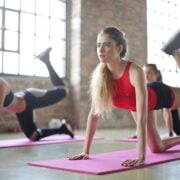
Get Fit in Six Days: A Dumbbell Workout Plan for Maximum Results
Dumbbell workouts have become increasingly popular in recent years, and for good reason. Not only are they a versatile and convenient form of exercise, but they also offer numerous benefits for those looking to get fit. Dumbbell workouts can help build muscle, increase strength, improve cardiovascular fitness, and even aid in weight loss. Whether you’re a beginner or an experienced gym-goer, incorporating dumbbell exercises into your fitness routine can help you achieve your goals.
One of the main reasons why dumbbell workouts are so effective is because they engage multiple muscle groups at once. Unlike machines that isolate specific muscles, dumbbells require you to stabilize your body and use a combination of muscles to perform the exercises. This not only helps to build overall strength but also improves coordination and balance. Additionally, dumbbell exercises allow for a greater range of motion compared to machines, which can help improve flexibility and joint mobility.
Key Takeaways
- Dumbbell workouts are effective for getting fit due to their versatility and ability to target multiple muscle groups.
- A six-day workout plan can provide numerous benefits, including increased strength and endurance.
- The science behind dumbbell workouts and muscle building involves progressive overload and muscle adaptation.
- Choosing the right dumbbell weight for your fitness level is crucial for avoiding injury and maximizing results.
- Warm-up and cool-down exercises are essential for optimal results and injury prevention.
Benefits of a Six-Day Workout Plan
A six-day workout plan offers numerous advantages for those looking to get fit. By working out six days a week, you can increase muscle growth and improve overall fitness at a faster rate. This is because the more frequently you train, the more stimulus you provide to your muscles, which leads to greater adaptation and growth.
In addition to increased muscle growth, a six-day workout plan can also help improve cardiovascular fitness. By incorporating both strength training and cardiovascular exercises into your routine, you can improve your heart health and endurance. This is especially important for those looking to lose weight or improve their athletic performance.
Furthermore, a six-day workout plan allows for greater variety in your workouts. By dedicating specific days to different muscle groups or types of exercises, you can ensure that you are targeting all areas of your body and avoiding overtraining. This can help prevent plateaus and keep your workouts challenging and engaging.
The Science Behind Dumbbell Workouts and Muscle Building
To understand why dumbbell workouts are effective for muscle building, it’s important to understand the science behind muscle growth. When you perform resistance exercises, such as dumbbell curls or squats, you create microscopic tears in your muscle fibers. These tears then repair and rebuild themselves during the recovery process, resulting in stronger and larger muscles.
Dumbbell workouts are particularly effective for muscle building because they allow for progressive overload. Progressive overload is the principle of gradually increasing the demands placed on your muscles over time. By using dumbbells, you can easily increase the weight or resistance as you get stronger, which helps to continually challenge your muscles and promote growth.
Additionally, dumbbell exercises engage stabilizer muscles, which are smaller muscles that help support and stabilize larger muscle groups. By targeting these stabilizer muscles, you can improve overall muscle balance and prevent imbalances or weaknesses that can lead to injuries.
How to Choose the Right Dumbbell Weight for Your Fitness Level
| Fitness Level | Dumbbell Weight | Repetitions |
|---|---|---|
| Beginner | 1-5 lbs | 12-15 |
| Intermediate | 5-10 lbs | 8-12 |
| Advanced | 10-20 lbs | 6-8 |
Choosing the right dumbbell weight is crucial for optimal results and preventing injuries. If the weight is too light, you won’t challenge your muscles enough to promote growth. On the other hand, if the weight is too heavy, you risk compromising your form and increasing the risk of injury.
A good rule of thumb is to choose a weight that allows you to perform 8-12 repetitions with proper form while still feeling challenged. If you can easily complete more than 12 repetitions, it’s time to increase the weight. Conversely, if you struggle to complete 8 repetitions with proper form, it’s best to decrease the weight.
It’s also important to consider your fitness level and goals when choosing a dumbbell weight. Beginners may want to start with lighter weights to focus on proper form and technique before gradually increasing the weight. Those looking to build muscle and strength may opt for heavier weights that allow them to perform fewer repetitions with higher intensity.
Warm-Up and Cool-Down Exercises for Optimal Results
Warming up and cooling down before and after your dumbbell workouts is essential for optimal results and injury prevention. A proper warm-up helps to increase blood flow to your muscles, improve joint mobility, and prepare your body for the upcoming workout. It should include dynamic stretches and exercises that mimic the movements you’ll be performing during your workout.
Some effective warm-up exercises for dumbbell workouts include arm circles, shoulder rolls, lunges, and bodyweight squats. You can also incorporate light cardio exercises, such as jogging or jumping jacks, to further increase your heart rate and warm up your muscles.
Cooling down after your workout is just as important as warming up. It helps to gradually lower your heart rate, prevent dizziness or lightheadedness, and promote muscle recovery. A proper cool-down should include static stretches that target the muscles you worked during your workout.
Some effective cool-down exercises for dumbbell workouts include standing quad stretches, seated hamstring stretches, and chest stretches. You can also use foam rollers or massage balls to release tension in your muscles and promote relaxation.
Day 1: Upper Body Dumbbell Workout Routine
Day 1 of the six-day workout plan focuses on the upper body. This includes exercises for the chest, back, shoulders, and arms. It’s important to perform each exercise with proper form and technique to maximize results and prevent injuries.
1. Dumbbell Bench Press: Lie on a flat bench with a dumbbell in each hand. Start with your arms extended above your chest, palms facing forward. Lower the dumbbells towards your chest while keeping your elbows at a 45-degree angle. Press the dumbbells back up to the starting position.
2. Bent-Over Rows: Stand with a dumbbell in each hand, palms facing your body. Hinge forward at the hips, keeping your back straight and core engaged. Bend your elbows and pull the dumbbells towards your chest, squeezing your shoulder blades together. Lower the dumbbells back down to the starting position.
3. Shoulder Press: Stand with a dumbbell in each hand, palms facing forward. Start with your arms bent at a 90-degree angle, elbows at shoulder height. Press the dumbbells overhead until your arms are fully extended. Lower the dumbbells back down to the starting position.
4. Bicep Curls: Stand with a dumbbell in each hand, palms facing forward. Start with your arms fully extended by your sides. Bend your elbows and curl the dumbbells towards your shoulders, squeezing your biceps at the top of the movement. Lower the dumbbells back down to the starting position.
Day 2: Lower Body Dumbbell Workout Routine
Day 2 of the six-day workout plan focuses on the lower body, including exercises for the legs and glutes. It’s important to maintain proper form and technique throughout each exercise to target the intended muscles and prevent injuries.
1. Goblet Squats: Hold a dumbbell vertically against your chest, with both hands cupping the top end of the dumbbell. Stand with your feet shoulder-width apart and toes slightly turned out. Squat down by bending your knees and pushing your hips back, keeping your chest up and core engaged. Push through your heels to return to the starting position.
2. Romanian Deadlifts: Hold a dumbbell in each hand, palms facing your body. Stand with your feet hip-width apart and knees slightly bent. Hinge forward at the hips while keeping your back straight and core engaged. Lower the dumbbells towards the ground while maintaining a slight bend in your knees. Push through your heels and squeeze your glutes to return to the starting position.
3. Lunges: Hold a dumbbell in each hand, palms facing your body. Stand with your feet hip-width apart. Take a step forward with your right foot and lower your body into a lunge position, keeping your front knee directly above your ankle. Push through your front heel to return to the starting position. Repeat on the other side.
4. Glute Bridges: Lie on your back with a dumbbell resting on your hips. Bend your knees and place your feet flat on the ground, hip-width apart. Press through your heels and lift your hips off the ground until your body forms a straight line from your knees to your shoulders. Squeeze your glutes at the top of the movement, then lower your hips back down to the starting position.
Day 3: Full Body Dumbbell Workout Routine
Day 3 of the six-day workout plan is a full-body workout that targets both the upper and lower body. This workout is designed to engage multiple muscle groups and provide a well-rounded training session.
1. Squat Press: Hold a dumbbell in each hand, palms facing forward. Stand with your feet shoulder-width apart. Squat down by bending your knees and pushing your hips back, keeping your chest up and core engaged. As you stand back up, press the dumbbells overhead until your arms are fully extended. Lower the dumbbells back down to shoulder height as you squat back down.
2. Renegade Rows: Start in a high plank position with a dumbbell in each hand, palms facing inward. Keep your core engaged and body in a straight line from head to toe. Row one dumbbell up towards your chest while keeping your elbow close to your body. Lower the dumbbell back down and repeat on the other side.
3. Reverse Lunges with Bicep Curls: Hold a dumbbell in each hand, palms facing forward. Stand with your feet hip-width apart. Take a step back with your right foot and lower your body into a lunge position, keeping your front knee directly above your ankle. As you lunge back, curl the dumbbells towards your shoulders. Push through your front heel to return to the starting position. Repeat on the other side.
4. Russian Twists: Sit on the ground with your knees bent and feet flat on the floor. Hold a dumbbell with both hands in front of your chest. Lean back slightly and lift your feet off the ground, balancing on your glutes. Twist your torso to the right, bringing the dumbbell towards the ground next to your hip. Twist back to center and then to the left side.
Day 4: Rest and Recovery Day
Rest and recovery days are just as important as workout days in a six-day workout plan. They allow your muscles to repair and rebuild themselves, which is crucial for muscle growth and overall fitness improvement. Rest days also help prevent overtraining and reduce the risk of injuries.
On day 4, it’s important to prioritize rest and relaxation. This can include activities such as gentle stretching, yoga, or low-impact activities like walking or swimming. It’s also a good time to focus on self-care practices such as foam rolling, massage, or taking a hot bath.
Active recovery is another option for day 4, which involves engaging in light exercise or activities that promote blood flow and muscle recovery without causing additional stress on the body. This can include activities like cycling, hiking, or practicing gentle yoga.
Day 5-6: Advanced Dumbbell Workout Routines for Continued Progression
For those who have been following the six-day workout plan for a while and are looking to continue progressing, advanced dumbbell workout routines can be incorporated on days 5 and 6. These workouts are designed to challenge your muscles and increase intensity.
Some advanced exercises that can be included in your workouts are:
1. Dumbbell Snatch: Start with a dumbbell on the ground between your feet. Squat down and grab the dumbbell with one hand, palm facing your body. Explosively stand up and pull the dumbbell up towards the ceiling, keeping it close to your body. As the dumbbell reaches shoulder height, rotate your hand and press it overhead. Lower the dumbbell back down to the starting position and repeat on the other side.
2. Dumbbell Thrusters: Hold a dumbbell in each hand, palms facing forward. Stand with your feet shoulder-width apart. Squat down by bending your knees and pushing your hips back, keeping your chest up and core engaged. As you stand back up, press the dumbbells overhead until your arms are fully extended. Lower the dumbbells back down to shoulder height as you squat back down.
3. Dumbbell Step-Ups: Hold a dumbbell in each hand, palms facing your body. Stand in front of a step or bench. Step one foot onto the step and push through your heel to lift your body up onto the step. Step back down with the same foot and repeat on the other side.
4. Dumbbell Push Press: Hold a dumbbell in each hand, palms facing forward. Stand with your feet shoulder-width apart. Bend your knees slightly and dip your body down, then explosively drive through your legs and press the dumbbells overhead until your arms are fully extended. Lower the dumbbells back down to shoulder height.
In conclusion, dumbbell workouts are an effective way to get fit and achieve desired results. By following a six-day workout plan and incorporating proper warm-up and cool-down exercises, individuals can see significant improvements in their overall fitness. With the right dumbbell weight and proper technique, muscle growth and strength can be achieved. By incorporating rest and recovery days and advanced workout routines, individuals can continue to progress and reach their fitness goals.
If you’re looking for a comprehensive 6-day dumbbell workout routine, you’ll definitely want to check out this article on Wave Magnets. They have put together a fantastic guide that covers everything you need to know about maximizing your dumbbell workouts. From targeting specific muscle groups to incorporating effective exercises, this article provides valuable insights and tips to help you achieve your fitness goals. Don’t miss out on this incredible resource – click here to read the article! https://wavemagnets.com/sample-page/
FAQs
What is a dumbbell workout?
A dumbbell workout is a type of strength training exercise that involves the use of dumbbells, which are handheld weights that come in various sizes and weights.
What are the benefits of a dumbbell workout?
A dumbbell workout can help build muscle strength, increase endurance, improve balance and coordination, and burn calories.
What is a 6 day dumbbell workout?
A 6 day dumbbell workout is a workout plan that involves using dumbbells for strength training exercises for six consecutive days.
What are some exercises included in a 6 day dumbbell workout?
Some exercises that may be included in a 6 day dumbbell workout include dumbbell squats, dumbbell lunges, dumbbell bench press, dumbbell rows, dumbbell curls, and dumbbell shoulder press.
What is the recommended weight for dumbbells in a 6 day dumbbell workout?
The recommended weight for dumbbells in a 6 day dumbbell workout will vary depending on the individual’s fitness level and goals. It is important to start with a weight that is comfortable and gradually increase the weight as strength improves.
Is a 6 day dumbbell workout suitable for beginners?
A 6 day dumbbell workout may not be suitable for beginners who are new to strength training. It is important to start with a less intense workout plan and gradually increase the intensity as strength and endurance improve.

















